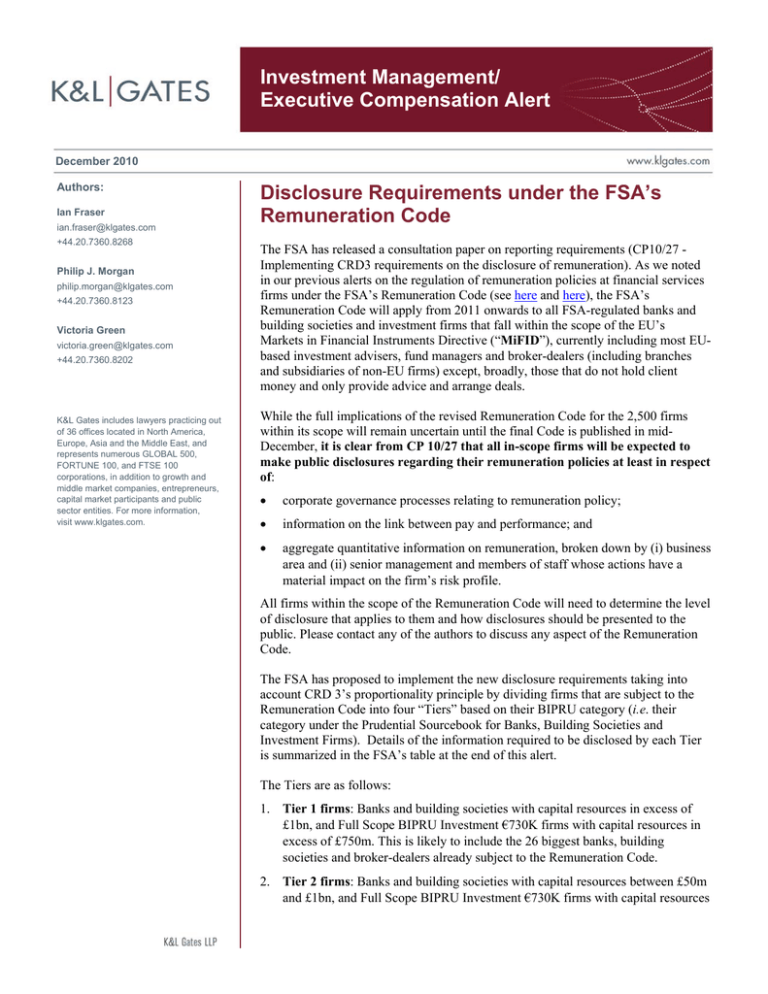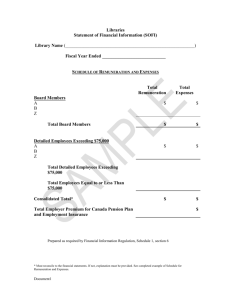
Investment Management/
Executive Compensation Alert
December 2010
Authors:
Ian Fraser
ian.fraser@klgates.com
+44.20.7360.8268
Philip J. Morgan
philip.morgan@klgates.com
+44.20.7360.8123
Victoria Green
victoria.green@klgates.com
+44.20.7360.8202
K&L Gates includes lawyers practicing out
of 36 offices located in North America,
Europe, Asia and the Middle East, and
represents numerous GLOBAL 500,
FORTUNE 100, and FTSE 100
corporations, in addition to growth and
middle market companies, entrepreneurs,
capital market participants and public
sector entities. For more information,
visit www.klgates.com.
Disclosure Requirements under the FSA’s
Remuneration Code
The FSA has released a consultation paper on reporting requirements (CP10/27 Implementing CRD3 requirements on the disclosure of remuneration). As we noted
in our previous alerts on the regulation of remuneration policies at financial services
firms under the FSA’s Remuneration Code (see here and here), the FSA’s
Remuneration Code will apply from 2011 onwards to all FSA-regulated banks and
building societies and investment firms that fall within the scope of the EU’s
Markets in Financial Instruments Directive (“MiFID”), currently including most EUbased investment advisers, fund managers and broker-dealers (including branches
and subsidiaries of non-EU firms) except, broadly, those that do not hold client
money and only provide advice and arrange deals.
While the full implications of the revised Remuneration Code for the 2,500 firms
within its scope will remain uncertain until the final Code is published in midDecember, it is clear from CP 10/27 that all in-scope firms will be expected to
make public disclosures regarding their remuneration policies at least in respect
of:
•
corporate governance processes relating to remuneration policy;
•
information on the link between pay and performance; and
•
aggregate quantitative information on remuneration, broken down by (i) business
area and (ii) senior management and members of staff whose actions have a
material impact on the firm’s risk profile.
All firms within the scope of the Remuneration Code will need to determine the level
of disclosure that applies to them and how disclosures should be presented to the
public. Please contact any of the authors to discuss any aspect of the Remuneration
Code.
The FSA has proposed to implement the new disclosure requirements taking into
account CRD 3’s proportionality principle by dividing firms that are subject to the
Remuneration Code into four “Tiers” based on their BIPRU category (i.e. their
category under the Prudential Sourcebook for Banks, Building Societies and
Investment Firms). Details of the information required to be disclosed by each Tier
is summarized in the FSA’s table at the end of this alert.
The Tiers are as follows:
1. Tier 1 firms: Banks and building societies with capital resources in excess of
£1bn, and Full Scope BIPRU Investment €730K firms with capital resources in
excess of £750m. This is likely to include the 26 biggest banks, building
societies and broker-dealers already subject to the Remuneration Code.
2. Tier 2 firms: Banks and building societies with capital resources between £50m
and £1bn, and Full Scope BIPRU Investment €730K firms with capital resources
Investment Management/Executive Compensation Alert
between £100m and £750m. This is likely to
include around 200 large banks, building
societies, broker-dealers and investment firms.
3. Tier 3 firms: Banks and building societies with
capital resources of less than £50m, and Full
Scope BIPRU Investment €730K firms with
capital resources less than £100m. This is likely
to include around 300 smaller banks, building
societies, broker-dealers and investment firms.
4. Tier 4 firms: All BIPRU Limited License and
Limited Activity firms. This is likely to include
around 2,000 investment firms that are not
Exempt CAD firms (see note).
Public disclosures must be made under the Pillar 3
reporting requirements, and may take the form of a
stand-alone report or be included in the firm’s
annual report and accounts. The first disclosure
under the new rules will be required by December
31, 2011.
Note: Limited License firms are, broadly, firms
other than banks that are not authorized to deal on
their own account or underwrite or place financial
instruments on a firm commitment basis. Limited
Activity firms are, broadly, firms other than banks
that have a base capital requirement of €730,000
and either (a) deal on their own accounts only to
execute client orders or to gain access to a clearing
system when acting as agent or (b) do not hold
client money or securities, do not provide
investment services other than dealing on their own
accounts, have no external customers for their
investment services, and whose transactions are
guaranteed by a clearing institution. Exempt CAD
firms are, broadly, firms that are only authorized to
provide investment advice and/or receive and
transmit orders from investors and do not hold client
money; these firms are outside the scope of the
Remuneration Code and are not subject to these
disclosure requirements.
Anchorage Austin Beijing Berlin Boston Charlotte Chicago Dallas Dubai Fort Worth Frankfurt Harrisburg Hong Kong London
Los Angeles Miami Moscow Newark New York Orange County Palo Alto Paris Pittsburgh Portland Raleigh Research Triangle Park
San Diego San Francisco Seattle Shanghai Singapore Spokane/Coeur d’Alene Taipei Tokyo Warsaw
Washington, D.C.
K&L Gates includes lawyers practicing out of 36 offices located in North America, Europe, Asia and the Middle East, and represents numerous
GLOBAL 500, FORTUNE 100, and FTSE 100 corporations, in addition to growth and middle market companies, entrepreneurs, capital market
participants and public sector entities. For more information, visit www.klgates.com.
K&L Gates comprises multiple affiliated entities: a limited liability partnership with the full name K&L Gates LLP qualified in Delaware and
maintaining offices throughout the United States, in Berlin and Frankfurt, Germany, in Beijing (K&L Gates LLP Beijing Representative Office), in
Dubai, U.A.E., in Shanghai (K&L Gates LLP Shanghai Representative Office), in Tokyo, and in Singapore; a limited liability partnership (also named
K&L Gates LLP) incorporated in England and maintaining offices in London and Paris; a Taiwan general partnership (K&L Gates) maintaining an
office in Taipei; a Hong Kong general partnership (K&L Gates, Solicitors) maintaining an office in Hong Kong; a Polish limited partnership (K&L
Gates Jamka sp.k.) maintaining an office in Warsaw; and a Delaware limited liability company (K&L Gates Holdings, LLC) maintaining an office in
Moscow. K&L Gates maintains appropriate registrations in the jurisdictions in which its offices are located. A list of the partners or members in each
entity is available for inspection at any K&L Gates office.
This publication is for informational purposes and does not contain or convey legal advice. The information herein should not be used or relied upon
in regard to any particular facts or circumstances without first consulting a lawyer.
©2010 K&L Gates LLP. All Rights Reserved.
December 2010
2
FSA’S PROPOSED APPROACH TO PROPORTIONALITY FOR FIRMS
Disclosure requirement
Information concerning the decision-making process used for
determining the remuneration policy, including, if applicable,
information about the composition and the mandate of a
remuneration committee, the external consultant whose
services have been used for the determination of the
remuneration policy and the role of the relevant stakeholders
(b)
Information on link between pay and performance
(c)
The most important design characteristics of the remuneration
system, including information on the criteria used for
performance measurement and risk adjustment, deferral policy
and vesting criteria
(d)
Information on the performance criteria on which the
entitlement to shares, options or variable components of
remuneration is based
(e)
The main parameters and rationale for any variable component
scheme and any other non-cash benefits
(f)
Aggregate quantitative information on remuneration, broken
down by business area
(g)
Aggregate quantitative information on remuneration, broken
down by senior management and members of staff whose
actions have a material impact on the risk profile of the credit
institution
indicating the following:
(i)
amounts of remuneration for the financial year, split
into fixed and variable remuneration, and number of
beneficiaries
(ii)
amounts and form of variable remuneration, split into
cash, shares and share-linked instruments and other
(iii)
amounts of outstanding deferred remuneration, split
into vested and unvested portions
(iv)
the amounts of deferred remuneration awarded during
the financial year, paid out and reduced through
performance adjustments
(v)
new sign-on and severance payments made during the
financial year, and number of beneficiaries of such
payments
(vi)
the amounts of severance payments awarded during
the financial year, number of beneficiaries, and
highest such award to a single person
In case of directors of credit institutions that are significant in terms of
their size, internal organization and the nature, scope and the
complexity of their activities, the quantitative information referred to in
this point shall be made available to the public at the level of directors
within the meaning of Article 11
Tier 1
firms
Tier 2
firms
Tier 3
firms
Tier 4
firms
9
9
9
9
9
9
9
9
9
9
(a)
9
9
9
9
9
9
9
9
9
9
(see
note)
9
9
9
9
9
9
9
9
9
Note: Tier 4 firms will need to disclose total remuneration broken down between senior management and staff with material risk
impact, but not the details in sections (g) (i) to (iv).







